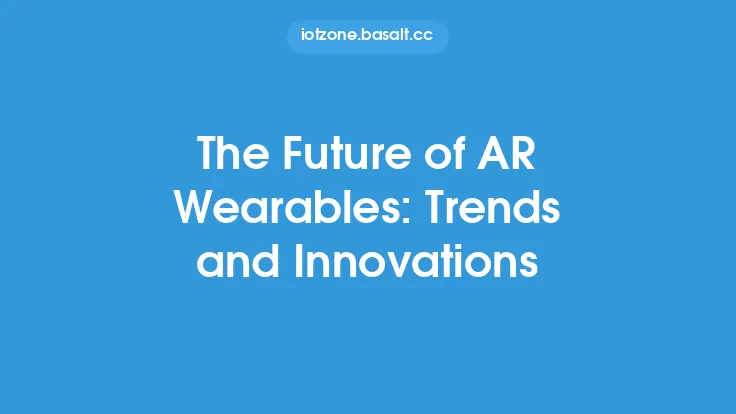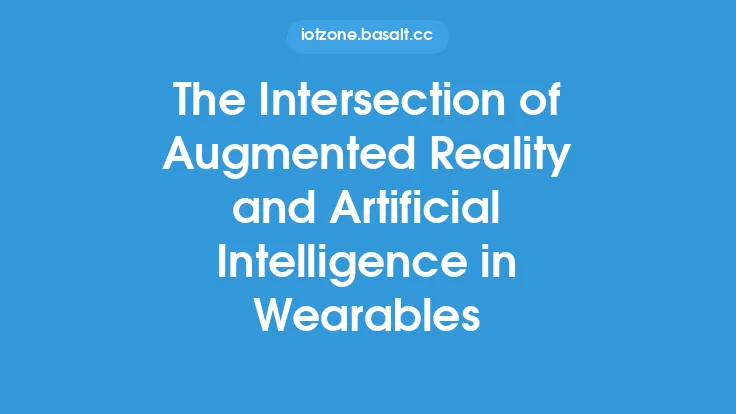The world of wearable technology has witnessed a significant surge in recent years, with augmented reality (AR) wearables being one of the most exciting and rapidly evolving segments. AR wearables are designed to enhance the human experience by providing users with a seamless blend of digital information and the physical world. As the technology continues to advance, it's essential to explore the benefits and challenges of adopting AR wearables, and what this means for individuals, businesses, and society as a whole.
Benefits of AR Wearables
The benefits of AR wearables are numerous and varied. One of the most significant advantages is the ability to provide users with real-time, context-specific information. This can be particularly useful in industries such as healthcare, where AR wearables can be used to display patient data, medical records, and treatment plans. In the field of education, AR wearables can be used to create interactive, immersive learning experiences that enhance student engagement and understanding. Additionally, AR wearables can be used to improve navigation, provide language translation, and offer virtual try-on capabilities for retail and e-commerce applications.
Another significant benefit of AR wearables is their potential to improve productivity and efficiency. By providing users with hands-free access to information and functionality, AR wearables can enable workers to complete tasks more quickly and accurately. This can be particularly useful in industries such as manufacturing, logistics, and field service, where workers often need to access complex information and instructions while performing tasks.
Technical Challenges of AR Wearables
Despite the many benefits of AR wearables, there are also several technical challenges that must be addressed. One of the most significant challenges is the need for high-quality, high-resolution displays that can provide a seamless and immersive user experience. This requires significant advances in display technology, including the development of high-resolution, see-through displays that can be used in a variety of lighting conditions.
Another technical challenge is the need for advanced computer vision and machine learning algorithms that can accurately track the user's environment and provide relevant, context-specific information. This requires significant advances in areas such as object recognition, tracking, and scene understanding, as well as the development of sophisticated machine learning models that can learn from user behavior and adapt to changing environments.
User Experience Challenges
In addition to the technical challenges, there are also several user experience challenges that must be addressed. One of the most significant challenges is the need to create intuitive and user-friendly interfaces that can be easily navigated by users. This requires significant advances in areas such as voice recognition, gesture recognition, and eye tracking, as well as the development of sophisticated user interface design principles that can provide a seamless and immersive user experience.
Another user experience challenge is the need to address issues related to user comfort and ergonomics. AR wearables can be bulky and uncomfortable to wear, particularly if they are designed with large displays or complex hardware components. This requires significant advances in areas such as materials science and industrial design, as well as the development of sophisticated ergonomics and human factors principles that can provide a comfortable and sustainable user experience.
Business and Investment Challenges
The adoption of AR wearables also poses several business and investment challenges. One of the most significant challenges is the need for significant investment in research and development, as well as the development of new business models and revenue streams. This requires significant advances in areas such as market research and analysis, as well as the development of sophisticated business planning and strategy principles that can provide a clear roadmap for investment and growth.
Another business and investment challenge is the need to address issues related to intellectual property and regulatory compliance. AR wearables often involve complex intellectual property issues, including patents, trademarks, and copyrights. This requires significant advances in areas such as intellectual property law and regulatory compliance, as well as the development of sophisticated risk management and mitigation principles that can provide a clear understanding of the potential risks and challenges.
Future Outlook
Despite the many challenges and complexities associated with AR wearables, the future outlook for this technology is extremely promising. As the technology continues to advance, we can expect to see significant improvements in areas such as display quality, computer vision, and user experience. We can also expect to see the development of new business models and revenue streams, as well as significant investment in research and development.
One of the most exciting areas of development is the integration of AR wearables with other technologies, such as artificial intelligence, blockchain, and the Internet of Things. This has the potential to create entirely new classes of applications and use cases, including smart homes, smart cities, and smart industries. As the technology continues to evolve, we can expect to see significant advances in areas such as augmented reality, virtual reality, and mixed reality, as well as the development of new and innovative applications that can transform industries and revolutionize the way we live and work.





